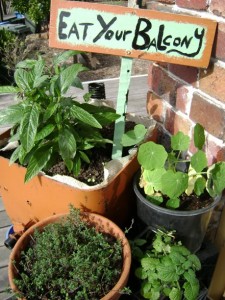 In today’s world of processed foods, pollution, and pink slime, you might be wondering how to ensure that what your family is eating is healthy.
In today’s world of processed foods, pollution, and pink slime, you might be wondering how to ensure that what your family is eating is healthy.
Buying organic is a great start, but growing it yourself opens doors to tremendous possibilities. Here’s why:
1. Avoid Pesticides – Conventional agriculture uses petroleum based chemicals to combat pests in the field, which not only damages the environment, but destroys important soil microbes that help plants grow. In your own garden, you can plant a diverse range of produce, instead of growing acres of one thing. This cuts down on pest attacks and can even attract beneficial insects to the garden to handle your pest problem for you. You can choose organic means of pest control, like soap sprays, hand-picking (the best pest control tool is your hands, after all) or other methods that don’t leave harmful residues on your food.
2. No-GMO Zone – GMOs (genetically modified organisms) or GE (genetically engineered) crops are everywhere you turn. 90% of soy and corn grown in the US is GE. As of this writing, GMO seed is not available to the home gardener, only commercial growers, though companies are trying to legalize GMO corn for home growers as we speak. Growing seeds that are heirloom or open pollinated ensures that those seeds are not genetically engineered, nor can they be patented by corporate seed companies. Buying seeds from companies who sign the Safe Seed Pledge goes further to make sure the seeds they sell have are not GE.
3. Get Outside – Kids and adults alike spend much of their free time glued to the TV or computer. Planting a garden gets everyone outside. Gardening provides exercise, and helps kids learn where their food comes from. Adults can learn a thing or two as well. Dive into the wonders of growing and harvesting potatoes. Watch beans climb their poles and flower into fruit. Learn about the evolution of sweet corn or the science behind composting. It’s fascinating stuff!
4. Lose the Lawn – Many states are being ravaged by drought, and yet we still throw water away every day by watering grass. Can you eat it? Not unless you’re a cow or goat. Vegetable gardens use water wisely to produce food for your family. Using drip irrigation and sustainable methods to capture water on site will put your water to a more valuable use, and you’ll reap the benefits at your dinner table.
5. Get Secure – Food security has become an issue for many who’ve lost their jobs, experienced rising prices, and especially for those living in “food deserts” where fresh produce is scarce. Planting a garden puts food at your finger tips. $1 worth of seeds can grow hundreds of dollars worth of tomatoes, lettuces, and other nutritious vegetables. Since most food travels 1,500 miles to get to consumers, growing your own food shortens the distance and saves gas and energy too.
Christy Wilhelmi is the author of Gardening for Geeks (April 2013, Adams Media), and the founder of Gardenerd.com.
Source: Living Green Magazine
OK, so there are the 5 reasons. Bet there’s 105 more. Share one here and let’s grow a long long list!